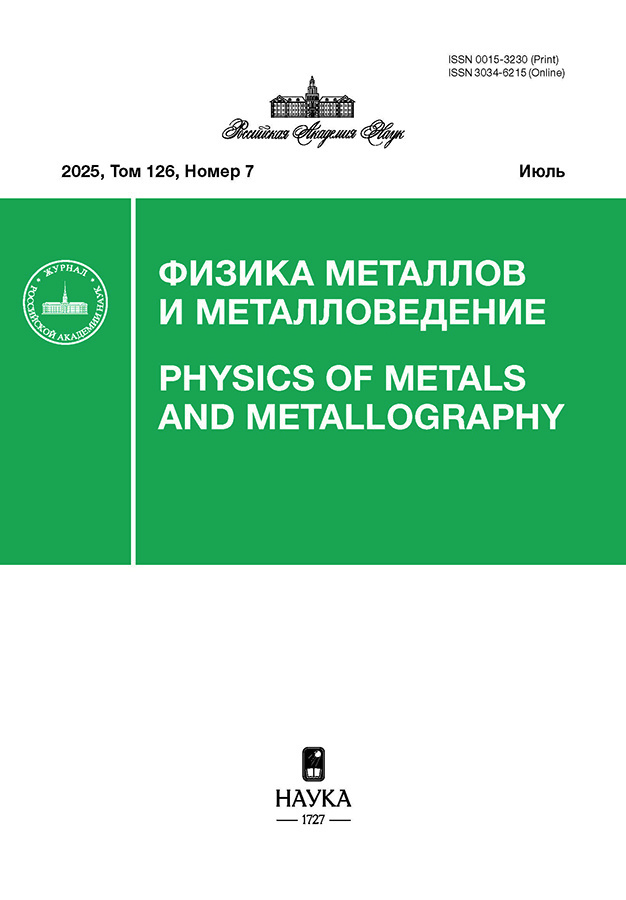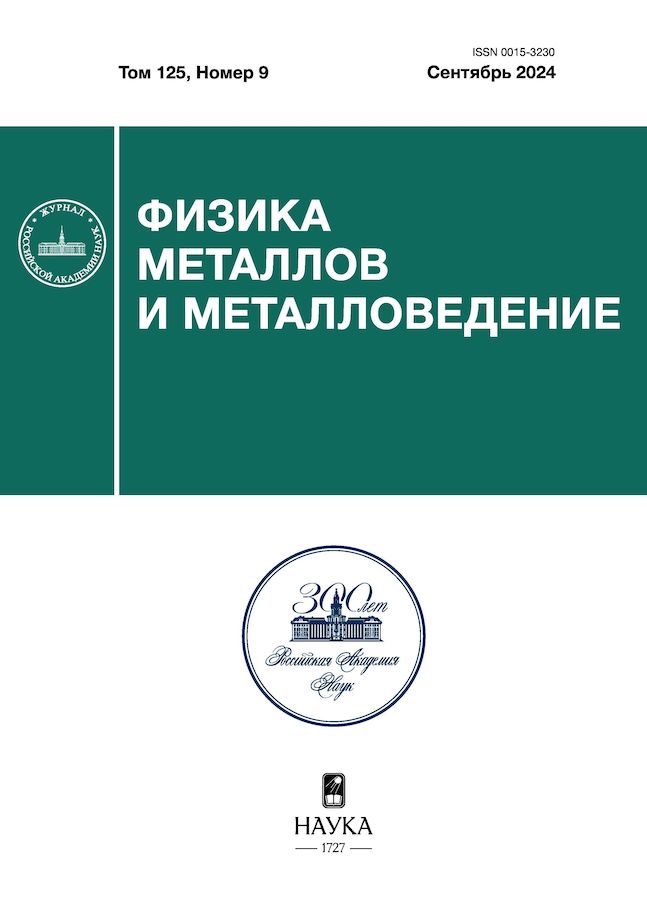Том 125, № 9 (2024)
СТРУКТУРА, ФАЗОВЫЕ ПРЕВРАЩЕНИЯ И ДИФФУЗИЯ
Анализ фазового состава системы Al–Cu–Mn–Ca как основы жаропрочных алюминиевых сплавов
Аннотация
Проведен анализ фазового состава сплавов системы Al–Cu–Ca–Mn, содержащих 6%Cu, 2%Mn и до 4% Ca (маc.%). Предложено строение фазовой диаграммы в области алюминиевого угла, согласно которой в твердом состоянии возможно наличие пяти четырехфазных областей с участием твердого раствора на основе алюминия (Al) и различных интерметаллидов. Для разработки жаропрочных сплавов нового поколения предлагается в качестве основы композиция Al–6%Cu–1%Ca–2%Mn. При таких концентрациях легирующих элементов возможно сочетание алюминиевой матрицы, содержащей дисперсоиды Al20Cu2Mn3, и эвтектики (Al)+Al27Ca3Cu7, характеризующейся тонким строением.
 1061-1069
1061-1069


Подходы к определению предельной скорости послойного лазерного сплавления металлов и сплавов
Аннотация
Проведена качественная оценка максимальной скорости обработки металлического порошкового материала, обеспечивающей получение изделия с высокой плотностью, при послойном лазерном сплавлении. Величина максимальной скорости определяется характерными значениями времени протекания основных физических процессов, обеспечивающих формирование сплошного материала при послойном лазерном сплавлении: нагрева, прогрева, расплавления, растекания.
 1070-1082
1070-1082


Влияние содержания хрома на термическую стабильность субмикрокристаллических однофазных сплавов системы Ni–Cr
Аннотация
Изучена термическая стабильность однофазных сплавов системы Ni–Cr (2, 5, 12.5 ат.% Cr), в которых при деформации сдвигом под давлением сформирована субмикрокристаллическая (СМК) структура. Проанализировано изменение при отжиге твердости, размера зерна и однородности рекристаллизованной структуры. Легирование никеля хромом повышает температуру начала рекристаллизации деформированного сплава на 150–250°С и температуру начала интенсивного роста зерна на 200–400°С в соответствии с увеличением содержания хрома. В исследованных СМК-сплавах рекристаллизация развивается путем опережающего роста отдельных центров. Увеличение содержания хрома в сплаве от 2 до 12.5% способствует уменьшению размера зерна и повышению размерной однородности рекристаллизованной структуры.
 1083-1092
1083-1092


Влияние горячей прокатки на фазовый состав, структуру и механические свойства метастабильного (α+β)-сплава на основе Cu–41 мас.% Zn с эффектом памяти формы
Аннотация
Выполнено комплексное исследование влияния горячей прокатки на структурно-фазовые превращения и физико-механические свойства метастабильного (a+b)-сплава с эффектом памяти формы Cu–41 мас.%Zn. Структурно-фазовые превращения были изучены методами оптической и электронной микроскопии, рентгенофазового анализа и дифференциальной сканирующей калориметрии (при нагреве). Обнаружено, что в сплаве происходит промежуточное бейнитное превращение наряду с образованием мартенситных фаз. Установлены особенности механического поведения сплава при испытаниях методом одноосного растяжения образцов после горячей прокатки и последующих термических обработок. Установлено, что горячая прокатка с суммарным обжатием на 90% и последующая термическая обработка приводят к увеличению пластичности сплава до 48%.
 1093-1099
1093-1099


Расчет пороговых энергий смещения в коррозионностойких аустенитных сталях
Аннотация
Методом молекулярной динамики (МД) смоделировано первичное дефектообразование в ГЦК-модельном сплаве на основе Fe–Cr–Ni, химический состав которого совпадает с концентрацией трех основных компонентов в коррозионностойких аустенитных сталях типа Х18Н10. Сгенерированная выборка, включающая в себя 12 960 событий образования радиационных дефектов, инициированных первично-выбитыми атомами (ПВА) Fe, Cr и Ni с энергиями 100 эВ ≤EPKA≤ 5 кэВ вдоль пятнадцати неэквивалентных кристаллографических направлений, использована для расчета средних пороговых энергий смещения. Показано, что в исследуемом материале средние пороговые энергии смещения атомов Fe, Cr и Ni совпадают и равны ⟨Ed⟩=28±1 эВ. Полученные данные МД-моделирования использованы для построения зависимости Ed от EPKA, которая распадается на два линейных фрагмента, определяемых механизмом дефектообразования. Определили значение Ecc≈0.8 кэВ, при котором образование изолированных точечных дефектов при низких энергиях ПВА EPKA≤Ecc сменяется дефектообразованием в каскадах столкновений, инициируемых ПВА с энергиями EPKA≥Ecc. На основании полученных результатов МД-моделирования модифицировали каскадную функцию в модели Кинчина–Пиза, чтобы учесть зависимость пороговых энергий смещения Ed от энергии EPKA.
 1100-1107
1100-1107


Модели и структуры в электрофизике высокоэнтропийных сплавов с лазерно-индуцированными фрактальными поверхностными объектами
Аннотация
Рассмотрена возможность управляемого синтеза нанодендритной структуры высокоэнтропийных сплавов (ВЭС). Обсуждаются фундаментальные результаты по электропроводимости в зависимости от топологической структуры для железосодержащих сплавов и соединений в дендритных ВЭС. Акцент сделан на теоретических и экспериментальных исследованиях структурных особенностей на поверхности ВЭС с объектами фрактальной размерности. Определено влияние локализованных кластерных неоднородностей на твердой поверхности на электрофизические параметры образцов с учетом энтропии смешения в поверхностных топологических структурах дендритного типа. Фрактальные структуры дендритов проанализированы как прототипы наноантенн. Показано, что главным принципом формирования функциональных характеристик подобных структур является концепция фазового перехода с параметрами возникающих топологических фрактальных структур (дендритов), которые могут выполнять роль стандартных термодинамических параметров, таких как температура и давление. Они и будут определять фазовые состояния среды, включая возможные тенденции и тренды к сверхпроводимости. При этом технология получения таких поверхностных наноразмерных топологических объектов, основанная на лазерной абляции, является достаточно простой и универсальной с управляемыми характеристиками параметров получаемых (возникающих) структур разной конфигурации.
 1108-1125
1108-1125


Об аномалиях теплового расширения/сжатия кристаллических решеток мартенсита в сплавах Ti–Ni И Ti–Nb–Zr
Аннотация
Методами рентгеновской дифрактометрии in situ и ex situ исследованы температурно-временные изменения параметров решетки мартенсита (ПРМ) сплавов с памятью формы Ti–50.26Ni и Ti–18Zr–12Nb (ат.%) с целью проверки существования временной зависимости ПРМ и выяснения, насколько строго сохраняется правильная сингония решетки мартенсита при изменении ее параметров в ходе нагрева–охлаждения в интервале температур от –180°С до ≥As. Изменения ПРМ обратимы во всем исследованном диапазоне температур при различных комбинациях скоростей нагрева и охлаждения (от 0.03°C/с до >50°C/с), величины ПРМ не зависят от времени рентгеновской съемки или выдержки при данной температуре в интервале существования мартенсита. Ширина рентгеновских линий В19'- и αʹʹ-мартенсита при любых комбинациях скоростей нагрева и охлаждения и временах выдержки не изменяется, что указывает на отсутствие искажений решетки мартенсита, подобных предмартенситным, приводящим к обратимому уширению рентгеновских линий аустенита с приближением к точке Мs в области формирования нанодоменов промежуточной структуры сдвига. Величина критерия Фишера (F), нигде не превышающая ее критическое значение, наряду с неизменностью ширины рентгеновских линий свидетельствует о сохранении неискаженной сингонии решетки непревращенных кристаллов мартенсита и изменении решетки как целого – путем постепенного однородного сдвига – при приближении к моменту их обратного превращения.
 1126-1141
1126-1141


Структурно-фазовые превращения в α-Ti в ходе различных типов деформации при комнатной температуре
Аннотация
Проведено исследование фазового превращения в технически чистом титане при различных способах деформации: осадкой в условиях высокого давления и кручения под высоким квазигидростатическим давлением. Набор современных структурных методов исследования включал микроиндентирование, дифракцию рентгеновских лучей, просвечивающую электронную микроскопию, а также EXAFS-спектроскопию в синхротронном излучении для подробного выяснения локальной атомной структуры фаз. Выявлена корреляция между протеканием фазового превращения и способом деформации. Показано, что деформация сдвигом под высоким давлением при комнатной температуре в отличие от осадки под давлением без сдвиговой компоненты способствует возникновению высокотемпературной β-фазы с локальным атомным порядком, отличным от такового в исходной фазе.
 1142-1149
1142-1149


Анализ структуры и распределения температуры в сварном шве дюралюминиевого сплава при сварке трением с перемешиванием
Аннотация
С помощью теоретического и экспериментального методов анализа проведена оценка влияния диффузионных и деформационных процессов на химический состав и структуру сварного соединения пластин из алюминиевого сплава (AlCuMg) в условиях сварки трением с перемешиванием. Для воспроизведения температурных условий в зоне сварки и оценки возможных причин изменений структуры и фазового состава материала в области сварного шва применены методы математического моделирования тепловых процессов. Полученные теоретические расчеты проверены и подтверждены с помощью экспериментальных методов структурного анализа (рентгеноструктурный анализ, сканирующая электронная микроскопия) и измерения микротвердости. Обнаружено изменение содержания кремния, меди и алюминия в составе твердого раствора исследуемого материала, а также изменение фазового состава (снижение количества фазы Al12Fe3Si и появление фазы AlCuFeMnSi), что связано с массопереносом в зоне сварного шва в условиях сварки трением с перемешиванием.
 1150-1162
1150-1162


Высокотемпературное in situ синхротронное исследование структурно-фазовых превращений в 3D-напечатанных титановых сплавах Ti–6Al–4V и Ti–5Al–3Mo–V
Аннотация
Методом электронно-лучевой проволочной аддитивной технологии получены образцы из титановых сплавов Ti–6Al–4V и Ti–5Al–3Mo-V. С помощью оптической, растровой и просвечивающей электронной микроскопии показано, что микроструктура 3D-напечатанных образцов состоит из столбчатых первичных зерен β-фазы, внутри которых формируются мартенситные αʹ-пластины. Методом высокотемпературной синхротронной рентгеновской дифракции продемонстрировано развитие в сплавах αʹ→α+β+αʹʹ-превращений, вызывающих увеличение содержания остаточной β фазы и образование орторомбической αʹʹ-фазы. Распад αʹ-фазы в образцах Ti–6Al–4V и Ti–5Al–3Mo–V начинается при температурах 600 и 400°C соответственно. Интенсивное окисление титановых сплавов внутри высокотемпературной камеры при температуре выше 900°C приводит к снижению объемной доли β- и α''-фаз, а также подавлению полиморфного α→β-превращения.
 1163-1170
1163-1170


Распределение состава по глубине межфазной границы двойных сплавов
Аннотация
На основе термодинамического подхода для двойных сплавов замещения в одномерном случае рассчитаны параметры диффузной межфазной границы и распределения состава внутри нее. Показано, что в модели квазирегулярного раствора оценка равновесных пределов растворимости совпадает с результатами построения Гиббса и подхода Кана–Хилларда. Установлено, что ширина межфазной границы слабо зависит от выбора используемых приближений. Сильная зависимость от них характерна для равновесных пределов растворимости. Также продемонстрировано, что отход от модели квазирегулярного раствора приводит к нарушению правила равных площадей Максвелла. Показано, что параметры, характеризующие форму кривой распределения состава внутри межфазной границы, имеют качественно различное поведение для модели квазирегулярного раствора и при расчете в общем случае.
 1171-1179
1171-1179


Влияние отрицательных температур на кристаллическую структуру, свойства и разрушение Cr–Mn–С–N-стали
Аннотация
Методами рентгеноструктурного анализа и трансмиссионной электронной микроскопии исследована структура литейной аустенитной Cr–Mn–C–N-стали при низких климатических и криогенной температурах. Показано, что при охлаждении закаленной стали изменяются параметры кристаллической структуры. При охлаждении от 20°С до –90°С параметр решетки аустенита уменьшается, при этом концентрация дефектов упаковки (ДУ) не меняется. При более низких температурах параметр ГЦК-решетки стабилизируется при том, что концентрация ДУ резко возрастает. Обнаружены зависящие от температуры смещения атомов ГЦК-решетки из своих равновесных положений. В плотноупакованных плоскостях {111} смещения больше, чем в плоскостях {200} во всем температурном интервале. Изменения в параметрах кристаллической структуры отражают процесс релаксации внутренних напряжений. В температурном интервале от –105°С до 20°С сталь демонстрировала комплекс высоких прочностных свойств σ0.2 до 800 МПа σв до 1100 МПа при удовлетворительной пластичности 10% и вязком характере разрушения. При –196°С сталь разрушается хрупко.
 1180-1188
1180-1188


ПРОЧНОСТЬ И ПЛАСТИЧНОСТЬ
Изменение структуры композита Fe–Ni–Ti–C–B при горячей пластической деформации
Аннотация
Исследовано изменение структуры и твердости композита системы Fe–Ni–Ti–C–B, полученного методом самораспространяющегося высокотемпературного синтеза (СВС), после горячей пластической деформации в условиях одноосного сжатия. Матрица композита – твердый раствор Ni и Ti в кристаллической решетке γ-Fe, упрочняющие фазы – TiC, TiB2, Fe2B, Ni3Ti и NiTi. Показано, что при одноосном сжатии при нагреве в металлической матрице композита происходят рекристаллизационные процессы, которые облегчают дальнейшую деформацию. Установлено, что после сжатия при температуре 910°С и давлении 300 МПа истинная деформация композита составила 0.37. При этом в центральной части образца в области сжимающих напряжений соотношение деформированных и рекристаллизованных зерен примерно одинаково. На боковой поверхности образцов в зоне действия растягивающих напряжений возникают микротрещины глубиной менее 0.2 мм в зонах эвтектического γ +Fe2B-строения.
 1189-1198
1189-1198













